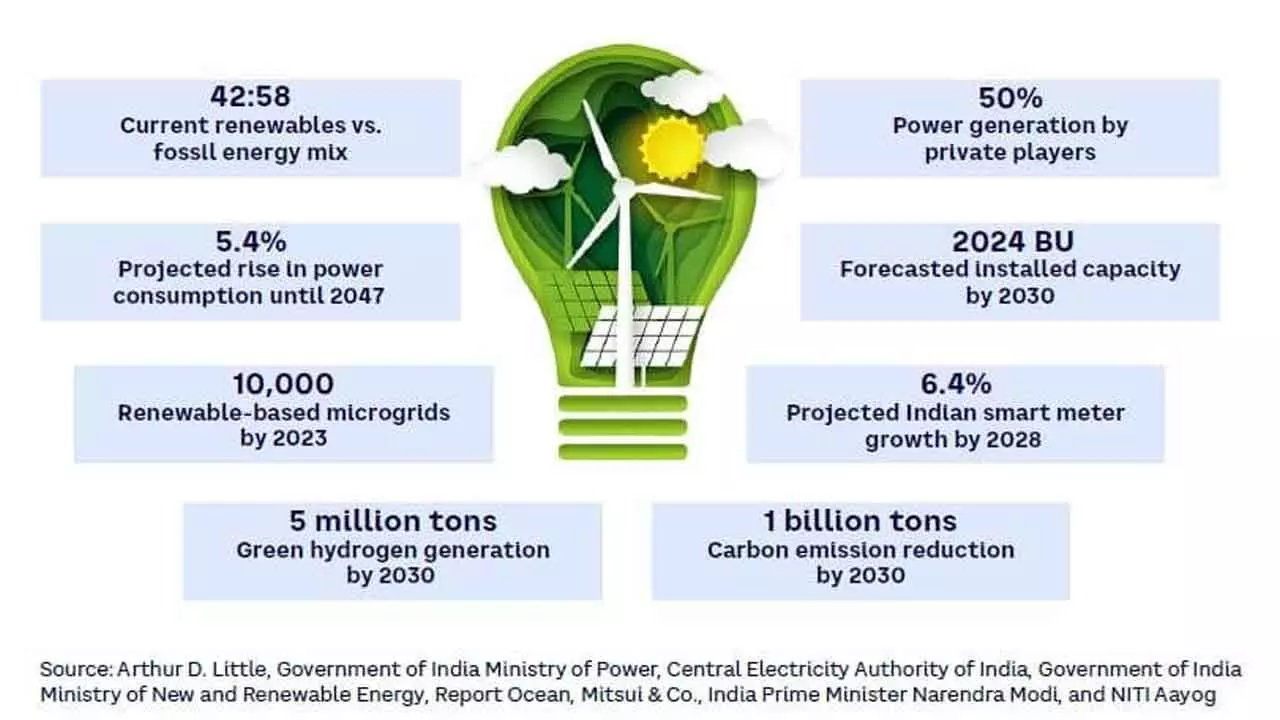Outlook for India’s renewable energy in 2024 is positive, opine experts
The National Green Hydrogen Mission with an outlay of Rs 19,744 crore was approved in January
image for illustrative purpose

Apart from solar and wind energy, India has increased its focus on green hydrogen in a big way to reduce dependence on fossil fuels, mainly diesel, which is required for long haul vehicles. India is a diesel-based economy in a way that most of the commercial vehicles for passenger and freight services are using diesel as the fuel
India will witness more than 83 per cent increase in investments in renewable energy projects to around $16.5 billion in 2024 as the country focuses on energy transition to reduce carbon emissions, according to power ministry estimates. This is in line with the ambitious target of having 500 GW of renewable energy by 2030 and its resolve to reduce overall power generation capacity from fossil fuels to less than 50 per cent.
India has committed a net zero emission target by 2070. However, Union Power and New & Renewable Energy Minister R.K. Singh has often said that around 65 per cent power generation capacity would be from non-fossil fuels by 2030 and that would be higher than the set target of 50 per cent.
In an interview, Singh said, "India is likely to witness 25 GW of renewable energy capacity addition entailing an investment of Rs. 1,37,500 crore in 2024, which would be higher than 13.5 GW with an investment of Rs. 74,250 crore seen in 2023."
Apart from solar and wind energy, India has increased its focus on green hydrogen in a big way to reduce dependence on fossil fuels, mainly diesel, which is required for long haul vehicles. India is a diesel-based economy in a way that most of the commercial vehicles for passenger and freight services are using diesel as the fuel.
In January this year, the Union Cabinet approved the National Green Hydrogen Mission with an outlay of Rs. 19,744 crore. Later in July, the Solar Energy Corporation of India (SECI) called bids for providing incentives for the production of 4,50,000 tonnes of green hydrogen and 1.5 GW of electrolyser manufacturing facilities annually. Around 21 firms bid for incentives for electrolyser manufacturing of 3.4 GW and 14 companies for green hydrogen production of 5,53,730 tonnes under the Strategic Interventions for Green Hydrogen Transition (SIGHT) Scheme (Mode-1-Tranche-I). Reliance Electrolyser Manufacturing, Adani New Industries, L&T Electrolysers and Bharat Heavy Electricals were among the 21 companies that bid for the incentives to set up 3.4 GW of annual capacity for manufacturing electrolysers.
The 14 companies that evinced interest for incentives to set up production facilities of green hydrogen were ACME Cleantech Solutions, Torrent Power, UPL, GH4INDIA, Aneeka Universal, Sembcorp Green Hydrogen India, Greenko ZeroC and CESC Projects, among others. The National Green Hydrogen Mission is aimed at making India a global hub for manufacturing this clean source of energy and is expected to lead to the development of five million metric tonnes per annum of green hydrogen production capacity by 2030. The mission provides for setting up of two green hydrogen hubs in the initial phase. The Ministry of Ports, Shipping and Waterways has identified three major ports -- Deendayal, Paradip, and V O Chidambaranar (Tuticorin) Ports -- to be developed as hydrogen hubs.
Singh said that the country has 7.8 million tonnes of green hydrogen capacity at different stages. The Strategic Interventions for Green Hydrogen Transition (SIGHT) scheme, backed by Rs. 17,490 crore, will help catalyse the production of green hydrogen and electrolysers, develop the green hydrogen ecosystem and enable industrial decarbonisation. Vineet Mittal, Chairman of CII's Taskforce on Green Hydrogen, said India's dedication to environmental sustainability aligns with the global shift towards green hydrogen and its derivatives.
"However, meeting the additional renewable energy demand and establishing a robust ecosystem for green hydrogen and green ammonia will be pivotal in 2024."
Leveraging the renewable energy potential, India can emerge as a production hub to meet the escalating demand for green hydrogen derivatives, said Mittal, who is also the Chairman of Avaada Group.
Observing that the outlook for renewable energy in 2024 was positive, Rahul Munjal, co-chairman of CII Renewable Energy Council and CMD of Hero Future Energies, said that there is an expectation of continued investment and technological advancements, particularly in areas of renewable energy and battery storage. A comprehensive vision outlined in the Central Electricity Authority (CEA) report on Optimal Generation Mix by 2030 targets 292 GW of solar, 100 GW of wind, and 18 GW of hydro, presenting ample opportunities for diverse investments in the sector.
"To achieve the goal of 292 GW solar installations and 100 GW wind installations by 2030, large-scale tenders (up to 5 GW) should be issued by REIAs (Renewable Energy Implementing Agencies) to maximise the execution capabilities of developers," Shekhar Dutt, Director General of Solar Power Developers Association (SPDA), said. He also pitched for mandating Green Hydrogen Consumption Obligations (GHCOs) for key industrial sectors to promote green hydrogen usage.
Girishkumar Kadam, co-group head - Corporate Ratings at ICRA, said that the installed renewable energy capacity, excluding large hydro, in India is estimated to increase to about 170 GW by March 2025 from the level of 132 GW as of October 2023. Moreover, he said the capacity addition thereafter is likely to be supported by the significant improvement in tendering activity in the current fiscal with over 16 GW projects bid out so far and another 17 GW bids underway by the central nodal agencies.
This is in line with the 50 GW annual bidding trajectory announced by the government in March, he added.

